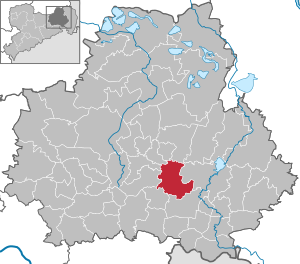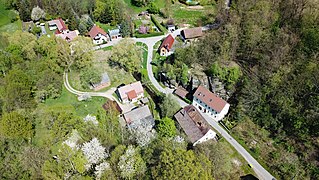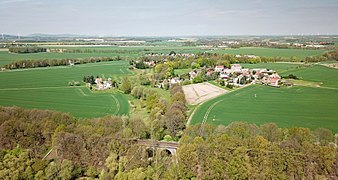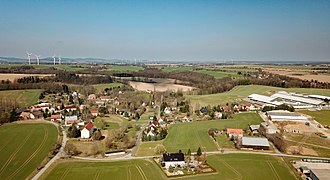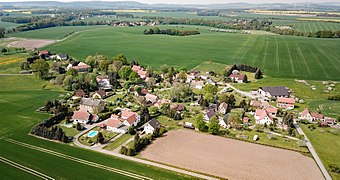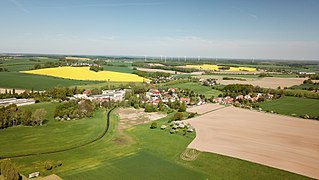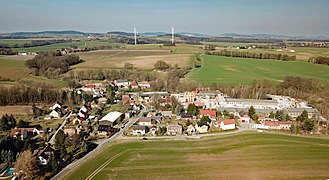Goeda
| coat of arms | Germany map | |
|---|---|---|

|
Coordinates: 51 ° 11 ′ N , 14 ° 19 ′ E |
|
| Basic data | ||
| State : | Saxony | |
| County : | Bautzen | |
| Height : | 210 m above sea level NHN | |
| Area : | 43.27 km 2 | |
| Residents: | 3063 (Dec. 31, 2019) | |
| Population density : | 71 inhabitants per km 2 | |
| Postal code : | 02633 | |
| Area code : | 035930 | |
| License plate : | BZ, BIW, HY, KM | |
| Community key : | 14 6 25 150 | |
| LOCODE : | DE GDR | |
| Community structure: | 32 districts | |
| Address of the municipal administration: |
Schulstrasse 14 02633 Göda |
|
| Website : | ||
| Mayor : | Gerald Meyer (independent) | |
| Location of the municipality of Göda in the district of Bautzen | ||
Göda , in Sorbian , is a place and the municipality of the same name in Upper Lusatia west of Bautzen . The community is part of the official Sorbian settlement area .
geography
The community of Göda is located in the fertile old settlements of the Upper Lusatian area west of the city of Bautzen. The place itself rises on the right bank of the Long Water , which has been crossed by a ford for centuries. Today's State Road 111 (formerly B 6 ) essentially follows the course of this old trade route. At the highest point in the village is the parish church of St. Peter and Paul. The Görlitz – Dresden railway line runs south of the village with the Seitschen stop in the municipality.
In the years 1897, 1945 and 1981 in particular, the Lange Wasser caused devastating floods that caused considerable damage. Therefore, several retention basins were built on the upper reaches after the Second World War. The Göda basin was put into operation in 1962.
Community structure
The municipality consists of 6 main districts, each of which has smaller villages:
|
|
history

The oldest demonstrable traces of settlement that were found in Göda itself date from the Bronze Age . Near the road to Seitschen is the so-called Alte Schanze , also called Gödaer Schanze , on the Langen Wasser , an oval ring wall that was used by the local Slavic Milzeners between the 10th and 13th centuries. A little further down the river, for example at the site of today's bridge over the Lange Wasser, there was already an important ford on Frankenstrasse around 1000 , on both sides of which rest houses were later built. The Sorbian village stood south of today's church, i.e. on the southern slope. Only with the arrival of the Germans and the construction of the church was the hilltop built on itself.
The place Göda was mentioned for the first time in 1006 in a document of the East Franconian King Heinrich II. As Burgward Godobi , who was donated to the diocese of Meißen along with two other castles. After Bautzen, Göda had been the second oldest parish in the Meissen diocese in Upper Lusatia since 1076 and as such a center of the Christian mission among the local Sorbs, which Bishop Benno von Meissen had started . Later, branch churches in Gaussig and Neschwitz and chapels in Uhyst am Taucher and Pohla were established. To the east of the old ski jump, a permanent knight's seat was built, which is known as the manor house in 1253. In the 13th century, the area of the episcopal property of Göda extended to the Sebnitz in the south and to the Röder in the west.
In the late 15th century, Stolpen Castle became the seat of a bishopric and Göda became the administrative center of the "Wendish Care", i.e. the Sorbian-speaking areas of the diocese. After its secularization in 1559, it came directly into the possession of the Saxon electors, so unlike large parts of Upper Lusatia, it was never Bohemian. Due to this special position, Göda initially remained a regional center of administration, church and lower jurisdiction, the latter no longer in the hands of the Göda pastor after 1559, but with the so-called Gödaer Dingstuhl , who exercised it until 1810.
Elector August had the Göda Latin School, which was mainly attended by Sorbian students, expanded and promoted. Young Sorbs were prepared at this school to study theology. A large proportion of the Sorbian-speaking Protestant clergy in the electorate began their training in Göda.
From the Middle Ages to the beginning of the 19th century , Göda was the meeting place of the Wendish regional court. Trials according to old Wendish law took place at this court. It was responsible for the Sorbian population in the wider area.
Population and language

Of the ample 3,100 inhabitants of the municipality, around 900 live in Göda itself. For his statistics on the Sorbian population in Upper Lusatia, Arnošt Muka determined a population of 574 for the place in the 1880s; 468 of them were Sorbs (82%) and 106 were Germans. Ernst Tschernik counted - due to the linguistic assimilation v. a. in the first half of the 20th century - 1956 a Sorbian-speaking population of only 24%. Today Sorbian is spoken as an everyday language only in the predominantly Catholic villages in the northern municipality area, mainly in Storcha , where there has been a Sorbian parish church since the 1890s, and in Dreikretscham .
In the 2011 census, 47.2% of the Göda community population were non-denominational, 39% belonged to the Protestant Church and 13.9% to the Roman Catholic Church, the latter mainly living in the northern districts. The Evangelical Lutheran parish of Göda today comprises 40 villages with around 2000 parishioners.
Culture and sights
The church of St. Peter and Paul with its characteristic double tower in the center of the village is visible from afar. The first church on this site was built in the 11th century and acted as a nucleus for Christianization in the Sorbian villages between the Picho mountain range and the monastery water . In the 16th century it was the parish church of a total of 75 villages.
It has had its current neo-Gothic appearance since 1892, when it was rebuilt by the Dresden architect Christian Schramm . However, various structural features such as the thick-walled substructure of the tower house, the cornice in the mortuary hall and the massive shape of the baptismal font can be traced back to the Romanesque . When the church was rebuilt under Bishop Johann VI. von Saalhausen between 1505 and 1518 a late Gothic hall church with a three-aisled nave and net vault was built . The sandstone pulpit, a holy water basin and, above all, the pointed arch windows have survived from this period to this day, while the tower and nave were ravaged by fire in the winter of 1580. Restoration began two years later. A hundred years later, the church tower burned down again in 1680.
Since the renovation between 1702 and 1714, several tombs of the Pirna sculpture school from the 16th and 17th centuries have been placed in the tower hall. In the cemetery surrounding the church is u. a. the grave of Jaroměr Hendrich Imiš .
Since 1965 there has been an annual witch burn and theater performance on the festival meadow near the ski jump .
politics
Municipal council
The elections of recent years have led to the following results:
| Parties and constituencies | 2019 | 2014 | 2009 | 2004 | ||||
|---|---|---|---|---|---|---|---|---|
| % | Seats | % | Seats | % | Seats | % | Seats | |
| Free voters (2004: FW Göda) | 47.8 | 8th | 59.7 | 10 | 59.2 | 10 | 60.4 | 10 |
| Christian Democratic Union of Germany (CDU) | 19.3 | 3 | 31.2 | 5 | 28.1 | 4th | 30.8 | 5 |
| Free Democratic Party (FDP) | 0.0 | 0 | 0.0 | 0 | 12.7 | 2 | 8.8 | 1 |
| THE LEFT | 7.1 | 1 | 9.1 | 1 | ||||
| AfD ("Alternative" for Germany) | 25.8 | 4th | ||||||
| total | 100.00 | 16 | 100 | 16 | 100.0 | 16 | 100.0 | 16 |
| voter turnout | 70.3% | 56.7% | 56.4% | 52.5% | ||||
Local partnerships
education
The municipality of Göda has a primary school. The middle school closed in 2006.
Personalities
- Michał Frencel (1628–1706), Sorbian pastor and Bible translator
- Jaroměr Hendrich Imiš (1819–1897), pastor in Göda from 1858 to 1897
- Jurij Pilk / Georg Pilk (1858–1926), historian, local researcher, musician, composer
Gallery of all villages in the municipality of Göda
literature
- Göda - millennial. Festschrift for the anniversary, ed. from the municipal administration of Göda. 2nd edition Lusatia Verlag, Bautzen 2006.
- Lausitzer Bergland around Pulsnitz and Bischofswerda (= values of our homeland . Volume 40). 1st edition. Akademie Verlag, Berlin 1983, pp. 85ff ..
- Cornelius Gurlitt : Göda. In: Descriptive representation of the older architectural and art monuments of the Kingdom of Saxony. 31. Booklet: Bautzen Official Authority (Part I) . CC Meinhold, Dresden 1908, p. 61.
Web links
- Official website of the municipality of Göda
- Göda in the Digital Historical Directory of Saxony
Individual evidence
- ↑ Population of the Free State of Saxony by municipalities on December 31, 2019 ( help on this ).
- ↑ Annex (to Section 3, Paragraph 2) of the Saxon Sorbs Act
- ↑ to Jannowitz
- ↑ with Buscheritz
- ↑ As of December 31, 2016; Information from the Göda municipal administration
- ↑ Ernst Tschernik: The development of the Sorbian population . Akademie-Verlag, Berlin 1954, p. 50 .
- ↑ 2011 census results: Göda
- ^ Georg Krahl: A thousand steps through Göda. In: Göda - millennial. Festschrift for the anniversary. P. 8
- ^ Rüdiger Laue: The Evangelical Lutheran Church Community of Göda from the Reformation to the present. In: Göda - millennial. Festschrift for the anniversary. P. 52ff.
- ↑ Results of the 2019 municipal council elections

